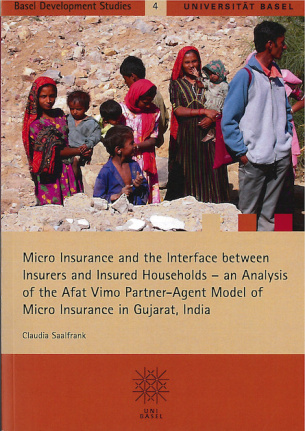
Herausgegeben von Prof. Dr. Rita Schneider-Sliwa, Dep. Umweltwissenschaften, Abt. Humangeographie der Univ. Basel
Vol. 4 Rita Schneider-Sliwa (Hg.)
Claudia Saalfrank
Micro Insurance and the Interface between Insurers and Insured Households
- an Analysis of the Afat Vimo Partner-Agent Model of Micro Insurance in Gujarat, India
Micro insurance, micro credit and micro savings are part of micro finance. Micro insurances operate like commercial insurance systems, but with a different target group: the poor. Household and business assets of the poor are often unprotected against perils. Insurance can serve as a solution to this vulnerability, if it is affordable and accessible. With 2.6 billion people worldwide living below the poverty line, there is a high demand and an unexploited market potential for micro insurance schemes.
The starting point of the present work is the assumption that micro insurance schemes work well and contribute to risk mitigation and poverty reduction by transferring risk onto third parties. However, if and to what extent these goals are achieved, or why they are not achieved, is not really understood. The present work analyses the Partner-Agent Model that is one delivery channel used to provide micro insurance. Within the Partner-Agent Model, insurers (the partner) work together with an organization of institution that has an existing interface with the low-income market (the agent) to reach policyholders.
There are flaws in the delivery of micro insurance and in particular in the Partner-Agent Model. The highest need for improvement in the Partner-Agent Model is at the communication level. The observation that beneficiaries had to wait too long for the insurance money requires a more efficient claim settlement process from the insurance companies (the partner) and the facilitators (the agent).
Micro insurance is recognized as being beneficial, whereas the potential benefits have not been completely realized due to flaws in the operative management. Micro insurance is rather a starting point in the process of reducing poverty and vulnerability, as it does not completely replace losses. Having insurance means that policyholders use the benefits of micro insurance schemes for bridging a gap instead of replacing the loss.
Bevorstehende Veranstaltungen
Bibliographische Angaben
| Reihe | Basel Development Studies |
|---|---|
| Seitenanzahl | 254 arabisch |
| Abbildungen | 118 s/w, 8 farbig |
| Tabellen | 96 |
| Zeichnungen | 35 |
| Format | 17 x 24 cm |
| Bindung | Buch, Broschiert |
| ISBN | 978-3-7965-2893-4 |
| Erscheinungsdatum | 20.12.2012 |